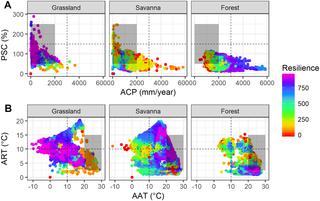PLOS ONE ( IF 2.9 ) Pub Date : 2018-03-19 , DOI: 10.1371/journal.pone.0194654 Luciano J S Anjos 1, 2 , Peter Mann de Toledo 2, 3

|
Climate change has been identified as the primary threat to the integrity and functioning of ecosystems in this century, although there is still much uncertainty about its effects and the degree of vulnerability for different ecosystems to this threat. Here we propose a new methodological approach capable of measuring and mapping the resilience of terrestrial ecosystems at large scales based on their climatic niche. To do this, we used high spatial resolution remote sensing data and ecological niche modeling techniques to calculate and spatialize the resilience of three stable states of ecosystems in South America: forest, savanna, and grassland. Also, we evaluated the sensitivity of ecosystems to climate stress, the likelihood of exposure to non-analogous climatic conditions, and their respective adaptive capacities in the face of climate change. Our results indicate that forests, the most productive and biodiverse terrestrial ecosystems on the earth, are more vulnerable to climate change than savannas or grasslands. Forests showed less resistance to climate stress and a higher chance of exposure to non-analogous climatic conditions. If this scenario occurs, the forest ecosystems would have less chance of adaptation compared to savannas or grasslands because of their narrow climate niche. Therefore, we can conclude that a possible consolidation of non-analogous climatic conditions would lead to a loss of resilience in the forest ecosystem, significantly increasing the chance of a critical transition event to another stable state with a lower density of vegetation cover (e.g., savanna or grassland).
中文翻译:

衡量南美洲陆地生态系统对气候变化的抵御能力和脆弱性
气候变化已被认为是本世纪对生态系统完整性和功能的主要威胁,尽管其影响以及不同生态系统对这一威胁的脆弱程度仍然存在很大的不确定性。在这里,我们提出了一种新的方法,能够根据气候生态位大规模测量和绘制陆地生态系统的恢复力。为此,我们使用高空间分辨率遥感数据和生态位建模技术来计算和空间化南美洲三种生态系统稳定状态的恢复力:森林、稀树草原和草原。此外,我们还评估了生态系统对气候压力的敏感性、暴露于非类似气候条件的可能性以及它们各自面对气候变化的适应能力。我们的研究结果表明,森林是地球上生产力最高、生物多样性最高的陆地生态系统,比稀树草原或草原更容易受到气候变化的影响。森林对气候压力的抵抗力较低,暴露于非类似气候条件的机会较高。如果发生这种情况,由于气候生态位狭窄,与稀树草原或草原相比,森林生态系统的适应机会将会更少。因此,我们可以得出结论,非类似气候条件的可能巩固将导致森林生态系统恢复力的丧失,从而显着增加发生关键过渡事件到另一个植被覆盖密度较低的稳定状态的机会(例如,稀树草原或草原)。









































 京公网安备 11010802027423号
京公网安备 11010802027423号